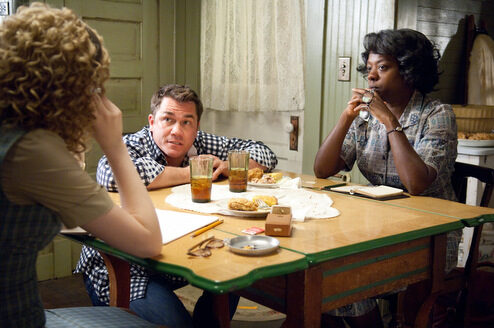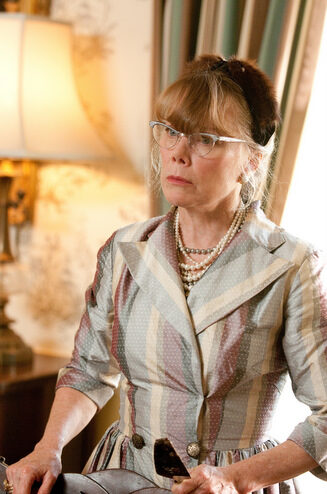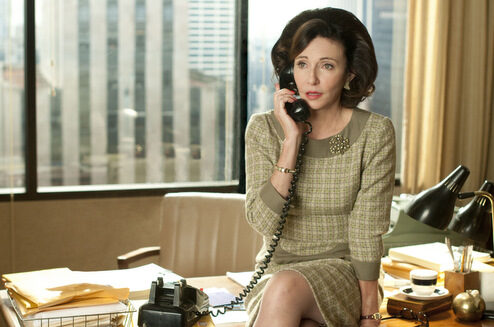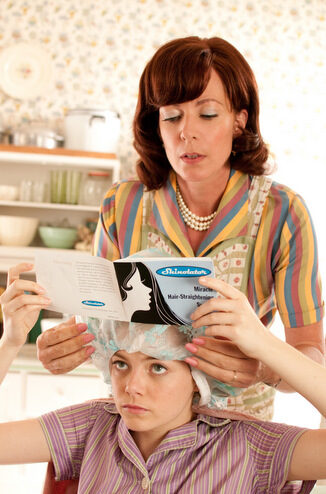The Help: Exclusive Interview with Director Tate Taylor | Clothes on Film
Clothes on Film talks exclusively to director of The Help, Tate Taylor, about his use of costume and make-up in the movie, Southern fashions and approaching his role from an actor’s perspective.
With only three features under his belt, Mississippi born Tate Taylor is relatively new to directing. Taylor’s work as an actor may be more familiar, a small but noteworthy part in Winter’s Bone (2010) perhaps his most high profile role. Coming from an acting background grants him rare insight into the filmmaking process; specifically how costume is employed on the other side of the camera.

Director Tate Taylor on set with Emma Stone (Skeeter) and Viola Davis (Aibileen).
For The Help, Tate Taylor retained twice Oscar nominated costume designer, Sharen Davis (Ray, Dreamgirls), to reproduce early 1960s Jackson, encompassing all its inhabitants; from white debutantes and ladies of leisure to the African American maids or ‘help’ who served them.
Clothes on Film, Chris: How important was costume authenticity to you on The Help?
Tate Taylor: I took every aspect of this film’s authenticity seriously, especially the costumes. Mississippi is a very specific place, and the Deep South has a tendency to be a little over the top. Everything is about fashion and food, and keeping up appearances. It was important to me that this did not get muted. This stayed exactly appropriate, and was not muted out of fear of modern day audiences going “Woah! What?”
The greatest gift to the film was Sharen Davis being our costume designer. She worked on Dreamgirls, she’s worked with Tarantino… my hat is off to her. She went into the homes of people in Mississippi. Many of these people had outfits and dresses from the period that they’d still kept; people don’t throw things away in the South, so we had this direct, tangible example of what people wear, and she recreated this absolutely.

Sissy Specek injected her own ideas about how she thought Missus Walters would dress.
CoF: Do you think that costume can inform character?
TT: Yeah! Right!! I come from an acting background, where you can be a character, and put on a pair of cowboy boots and become another character; same with all actors. Sissy Spacek and I talked about that. I wanted my actresses to have subtle nuances and to be able to integrate them in there. Sissy said “I want to wear hats. I think Missus Walters, before her mind started to go, went out with her husband to dinner in hats. That was her favourite thing”. That’s how the hats came in.
With Hilly there’s always a one-upmanship that she’s trying to employ. And I took that a step further, and in Bryce’s dialogue many times you will hear her talk about some fabric that she’d just bought. I mean, absolutely… character so informs that.
Sharen Davis did an amazing job. Like with Skeeter – do the bare minimum. She doesn’t want to be riding about in Easter Egg outfits; she’s serious. Sharen and I even worked harder on the uniforms that the maids wore.

Octavia Spencer (Minny) and Viola Davis wearing traditional maids’ unforms of the time, though these would likely have been starched white cotton in real life.
CoF: Of course most clothes would have been home-made. You reference this in the script at one point with Elizabeth Leefolt…
TT: Actually there weren’t a lot of home-made clothes in the sect of the girls. Elizabeth…her family is struggling with money. It’s played up more in the book, but she HAS to make her own clothes, but wants them to look store-bought. It’s sheer hobby, a lot of sewing.
CoF: It must have been difficult to give the maids a costume personality because they were all dressed identically…
TT: Sharen was so relieved by the fact that we got to see these maids at home, which makes it even more interesting when we see their real personalities at home; and then they have to put on these boring, simple outfits. One accentuates the other. That was when these women finally got to express themselves, in church. All week these women have to wear grey and white, so they wouldn’t put on a grey and white church dress!

Taylor denies that Emma Stone’s untreated curly hair and pared down make-up were an attempt to make Skeeter more accessible to a contemporary audience.
CoF: Looking at Skeeter, was her look tailored to be more accessible to a contemporary audience, e.g. her hair and make-up are very modern?
TT: No, her hair is not modern actually. We did a lot of research. Emma wears a wig in the movie, and wigs can be so trappy. I wanted to honour the character in the book, and I know who Catherine had in mind. A girl we went to high school with, who had hair like this. That hair was not just invented in the 70s or what-not. It’s been around, it’s just that women did things to treat it, and Catherine enjoyed the fact that Emma’s character did not care and did not treat it. That’s probably why it seems modern, because she did a very rebellious thing in the 60s by not treating it. So what seems modern, is basically people later in life having embraced their hair and their curls, and it’s now fashionable.
CoF: And this is covered in the film, isn’t it?
TT: Right. She does straighten her hair, and then she looks like the rest of them. And Skeeter’s make-up might seem modern, because she is a woman in the 60s who chose not to wear much. And so… guess what? That’s what people do now. I’m from the Deep South and one thing that has always remained true is that women wear too much make-up; they still do. I go to Mississippi and think “What are all these clowns doing walking ‘round the airport? All this lipstick and shadow!”

Change 1 costume sketch for New York magazine publisher Elain Stein by Gina Flannigan.

As seen in the movie portrayed by Mary Steenburgen.
CoF: Obviously you’ve been an actor. How do you find that affects your use of costume in film?
TT: The best thing about being an actor and then a director on film is the way I am able to talk to the actors. I’ve been in their shoes; I know what their insecurities are. So when I come to give them direction I know how to talk to them because I know how I would want someone to talk to me. It’s an entry pass into this world of communication. It gives me a right to talk to them in a certain way. You know like “Oh wait! He’s done this!” And we have a shorthand of how to talk to each other because I’ve been in their shoes. “You know when you did this?” “Hmm…” “You know when you did that?” “Hmm”. It’s that versus directors who have not been able to deal with actors…who have not been actors, saying “I need you to be more……do that more”.
CoF: I believe you worked with a friend of mine, Rebecca Hoffherr on Winter’s Bone?
TT: Yes! Winters Bone was fantastic and she was great. My heart’s in independent film. That’s all I ever done before this. In many ways, The Help felt like an independent movie with money. We were left alone, we had to improvise. But 25 million dollars for a movie like this, with all those period costumes, does not go far.

Allison Janney as Charlotte, Skeeter’s mom. Taylor admits that many women of a certain age in Mississippi still indulge the bright colours and heavy make-up look.
CoF: So how did you manage to make the movie you wanted?
TT: Well, I brought it to Mississippi and I’m a home-town boy, and I was able to get things free for us. People were behind me so they were giving things. This doesn’t happen in Los Angeles – everybody wants to be paid.
CoF: Returning to costume, did you and Sharen have an overall approach stylistically, i.e. a colour palette?
TT: I cannot take away from Sharon. She was so wonderful, because as a director you have to make so many decisions. I said “Sharen, I want you to come to me with at the most three choices. And after I have picked my first choice, you must tell me what your first choice was. Just give me three; I don’t need to see a thousand”.
I’m a very personality-driven director. I mean it is fun to break bread and be with whoever you like. But if you can communicate, and look into each other’s eyes and really talk, normal vulnerabilities are there but other hang-ups and ego is not there; you KNOW you will be able to really communicate. She was fantastic; so dedicated, such a great person, and we had real conversations. We would be in meetings and I would have to make a decision, but there would be no ego or “I don’t like that!” She would say “These are the three I think”. I would always say “Ok, being a novice, I like that one. Which one do you like?” She would say “Hmm… that one”. I’d say “Why?” and she would teach me.

‘Always hiding something’: Stuck up town ringleader Hilly (Bryce Dallas Howard).
CoF: Did it always run smoothly? No fights?
TT: No! Even with my production designer. I would say “Give me three choices”. He’d say “Oh, we could do this” and I’d say “No. Show me three”.
CoF: That’s your process then?
TT: Yeah. Usually people in the movie business, they give you ten choices, and usually the differences can be so slight because they’re so into it. So I would make them pick three.
CoF: Is there any character you’re particularly happy with how they turned out on film?
TT: Um, (pauses) Hilly. The Hillys are still in Jackson; I’m friends with a couple. No matter how much they try to dress down, they dress like that always. I love what that says about what they’re hiding.
CoF: It’s a facade…
TT: (emphatic) Yes.

Change 22 costume sketch for Skeeter by Gina Flannigan. Skeeter’s clothes gradually become more traditionally feminine towards the end of the film.
CoF: Do her costumes intentionally become darker towards the end of the film?
TT: No, it’s because of editing. I moved scenes around. It wasn’t intentional. Emma (Stone) begins to look a little bit more feminine. That was done on purpose, but no one else. There does appear to be more night-time scenes towards the end of the film: the Benefit Ball, their writing and hiding at night – a lot of things start happening at night, dates and stuff. That’s just sheer coincidence. If you think it was intentional… brilliant! I’ll claim it. “Yeah, Mr Taylor chose to slightly change the colours here!” (Laughs).
CoF: So what about your next project? Will you be moving away from this style of story and themes?
TT: I don’t look for a style. I’m writing three screenplays now that are all very different. I’m just looking for good material. I will always want multi-character pieces; these are the kind of films I like.

Attending church was one occasion when maids really got to be themselves; their colourful dresses and accessories reflect this.
CoF: How about a possible return to acting?
TT: I love acting. I don’t pursue it. I’ve been asked to do something; I’ve got to read the script in December. I’m not opposed to it. I think the reason I will continue to act above and beyond is to maintain my status of being on the inside with my actors. I mean when I came to Mississippi and Winter’s Bone had just come out and actors were coming onto set who had seen ‘Winter’s Bone’… I mean, I had a small part but I was in it, it was automatically a comfort level for me to tell them about my performance.
CoF: Well, thank you very much for talking to us.
TT: Man, I enjoyed that! Great questions. It was great to look at this from another angle.
With thanks to Tate Taylor.
The Help is released nationwide in the UK on 26th October.
© 2011, Chris Laverty.
Related Posts: